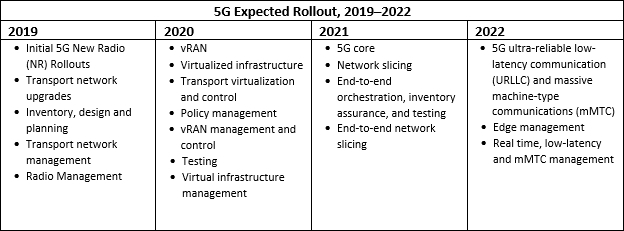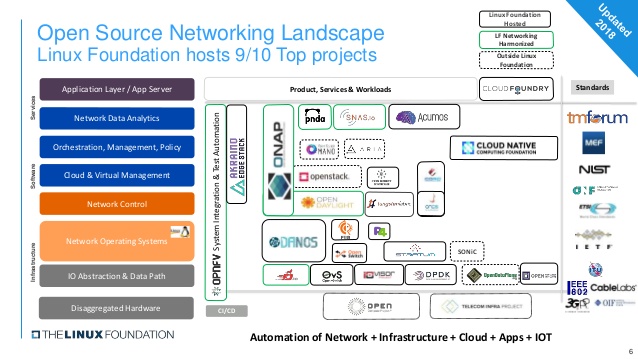
The 5G network is virtualized through a complex interlinking of individual components running as Virtual Network Functions (VNFs), and network slicing. While VNFs have been around for a while, network slicing presents itself as the next step in SDN technology—amounting to full virtualization of the network from radio to core. The separation of the network into VNFs and Network Slicing provides a huge leap forward in network flexibility, but the price of this advancement is that it will make orchestration and management much more complex.
My earlier blog, “A Domain Approach Could Simplify 5G Network Management,” examined the potential benefits of domain-based management as a remedy for the inherent complexity of 5G networks. In this article, I’m looking at the real-world OSS and orchestration challenges we’re encountering as we work with customers towards full 5G roll-out, including the timelines and best practices to prepare the 5G operations toolset.
Breaking Down the Challenges
5G OSS and orchestration present challenges in three primary areas:
- Mobile network: Virtualization of the Radio Access Network, the new 5G core, transport architectures built for slicing, and large-scale virtualized infrastructure
- Software platforms: SDN/NFV management for increasingly prevalent open source in the OSS, as well as for Linux Foundation networking and edge initiatives
- 5G services: A new, distributed approach to enable management for ultra-reliable, low-latency, and massive machine communication services
The Timing
According to Heavy Reading’s March 2019 survey of 5G operators, almost 80% of them expect to deploy 5G technology in the next two years. At least half expect to start transport upgrades for 5G by the end of 2019. Finally, by 2022, these operators expect to see the arrival of massive machine type communications and network slicing.
The evolution of OSS and orchestration should focus first on new radio and transport, followed by vRAN, and then on new services and slicing.
Key Functional Areas
Key functional areas within a domain-based management approach include:
- vRAN and radio management and control
- Transport network management and control
- Virtualized infrastructure orchestration and management
- Core network management
- End-to-end: inventory, service orchestration, policy management and assurance
- Network slice management
- Design, planning and testing
These areas align with the expected rollout of 5G, as shown in the table below:

Enabling Technologies
Enabling technologies we expect to see include the following: which align with the notional rollout of 5G:
- Linux Foundation networking and edge open source (i.e. ONAP, ODL, Akraino):
- AI and machine learning
- O-RAN – Radio intelligence controller and open APIs
- Virtualized infrastructure management and orchestration: open-source MANO, OpenStack, Kubernetes, Akraino
- Standards from 5GPP, ETSI and others.
The Linux Foundation provides a useful summary of these inputs in their Open Source Networking Landscape diagram, as reproduced below (Source: Heather Kirksey, VP Linux Foundation):

What’s Next?
The current state of open-source networking technology means that operators must move carefully, since it is not clear which projects will gain stable traction in the market. There’s no guarantee what direction the market will take, and competing projects risk wasting valuable resources. A phased approach is necessary, with transport and requirements specific to 5G NR taking precedence.
AI and machine learning have become critical due to the scale and real-time nature of 5G. Defining AI use cases and using machine learning to tune AI solutions for 5G will be essential, and the 5G core needs to be managed as part of the end-to-end solution, which also includes coordination of network slicing across all parts of the network.
When it comes to the edge of the network, Multi-Access Edge Computing and IoT will bring new requirements for management:
- Edge management provides low latency
- Coordination between IT resources at the edge, and the vRAN and transport networks ensure real-time demands can be met.
- IoT brings a high volume of devices to the network that require new approaches to bring high volume, energy efficient management.
Conclusion
Each phase of mobile networking across initial roll-outs of 2G, 3G and 4G, introduced OSS and orchestration to manage that specific network’s infrastructure and services. In the past, these deployments often took place after the fact, and were typically built independently for each part of the network. This led to the creation of OSS silos for each part of the network, with little correlation between them. This process won’t work for the 5G network.
5G needs a new way of thinking about end-to-end management. Openness, virtualized infrastructure, real-time services, and the volume of devices and cell sites all play a role. A careful, planned, and timely rollout out is needed for OSS and orchestration. Only then can operators deliver a successful 5G experience.